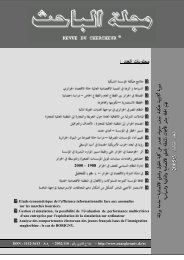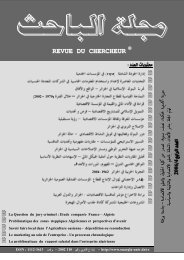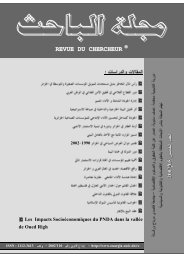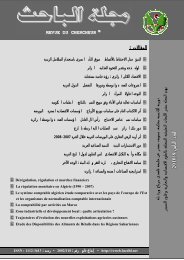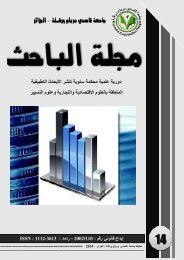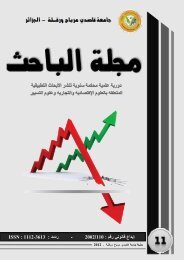El-BAHITH REVIEW Number 09 _ University Of Ouargla Algeria
Annual refereed journal of applied reserch in economic, commercial and managment sciences
Annual refereed journal of applied reserch in economic, commercial and managment sciences
Create successful ePaper yourself
Turn your PDF publications into a flip-book with our unique Google optimized e-Paper software.
_______________________________________________________________________________________________________________________________________<br />
مجلة الباحث – عدد 2011 / <strong>09</strong><br />
there is always a mismatch between aggregate savings and aggregate investment in the market<br />
economies of the real world. This is the fundamental source of disequilibrium and trade cycles in<br />
the capitalist economy, and also the target of most of the macroeconomic policies. Thus, in a full<br />
employment capitalist economy, personal saving, taken on its own, is always problematic as<br />
Keynes, J.M., has shown. Furthermore, there is no necessary theoretical relationship between real<br />
investment and personal domestic savings. What is needed is surplus income, but this surplus<br />
needn’t be saved by individuals before it is used to finance real investment.” (Braima 1995).<br />
According to Burrows and Theodor (1974), “Consumers can allocate their disposable income<br />
to expenditure on goods and services or to savings". The simplest form of the hypothesis is that the<br />
level of consumption planned by consumers depends on the level of their disposable income. The<br />
level of consumption and saving planned by consumers must add up to the level of income.<br />
Consequently, if consumption varies with the level of income, so must saving. Accordingly, the<br />
savings function takes the form:<br />
S = S(y) , 0 < S'(y) < 1<br />
Samuelson (1976) argued that “An individual may wish to save for a great variety of reasons:<br />
to provide for his old age or for a future expenditure … thrift may simply be a habit". He also<br />
argued that "An important use of after-tax income is saving for the future rather than consuming<br />
now … it is a matter of common observation that rich men save more than poor men, not only in<br />
absolute amounts but also in percentage amounts. The very poor are unable to save at all. Instead<br />
they ‘dissave’…. Thus, income is a prime determinant of saving”. A similar argument was<br />
advanced by Leavačic (1976), Noel (1980) and Harvey (1977, 1985).<br />
In addition to income, savings are also positively related to the interest rate (Burrows and<br />
Theodor ,1974). Along the same lines, Todaro (1977) argued that “Monetary savings can simply be<br />
stored for future use, but in most cases their ‘real’ value will probably decline due to inflation.<br />
Alternatively, savings can be deposited in a bank to earn interest, so that their real value may<br />
increase to the extent that the interest rate paid by the bank exceeds the rate of inflation”. In<br />
contrast, Leavačic (1976) argued that the rate of interest is not an important determinant of<br />
savings.<br />
According to Harvey (1977, 1985) the standard macroeconomics theory for industrial<br />
countries assumed that investment and demand for money vary inversely with interest rate.<br />
However, this theory is irrelevant for Africa, because there are insignificant bond markets, and the<br />
money supply is uncontrolled by the central bank.<br />
-23-





